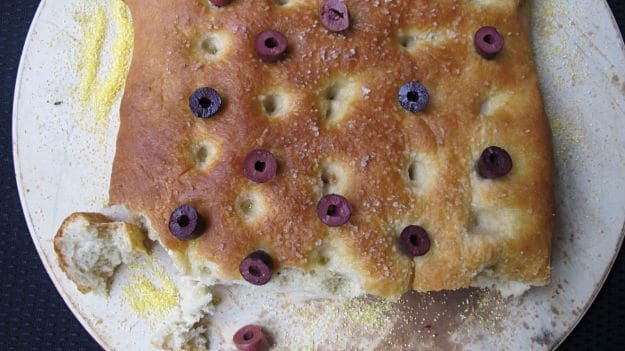An Italian staple with classical roots (panis focacius being Latin for "hearth bread"), this salty, olive-oil soaked flatbread is found from Bari to Bologna. It is most closely associated with Liguria, in the north-west of the country, where it bears little resemblance to the soft, finely textured stuff sold in many British supermarkets. Fortunately for fans of the authentic product's rich, chewy texture and crisp, salty crust, it's very easy to make at home.
The flour
Your choice of flour depends very much on what kind of focaccia you're after. Using plain flour, as in Marcella Hazan's Essentials of Classic Italian Cooking, or even finer "tipo 00" flour as in The River Cafe Classic Italian Cookbook, will give you a softer, more tender crumb; while Richard Bertinet's mixture of strong bread flour and coarse semolina in his book Dough creates a more robust, chewy texture.
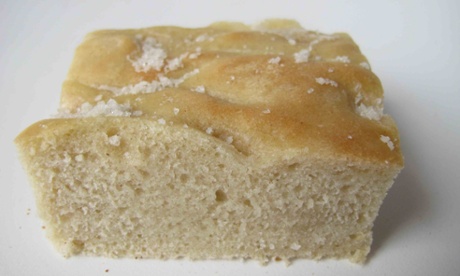
Giorgio Locatelli's book Made in Italy explains that, in his restaurant, they use "Italian extra-strong flour, which has a good elasticity and the power to absorb water well". As it isn't widely available in this country, he recommends using equal parts strong bread flour and 00 for a similar result, and I agree - his loaf does have a pleasingly springy texture without being quite as stiff as those that use strong flour alone.
Angela Hartnett* is among that number, but her recipe begins with a biga, or starter, which requires a 24-hour fermentation before use. Her bread has a wonderful chewiness and excellent flavour - almost more like a ciabatta than the focaccia I'm used to - but I'm looking for a loaf that can be made fairly quickly and easily, which rules this step out. If you're intrigued, however, the recipe from her book Cucina can be found here.

Though I'm not going to put semolina flour in the bread itself, I do like the crunch it lends Bertinet's version, so I will be dusting the baking tray with it, as I do when making pizza.
*Those surprised by the impressively browned crust on Angela's focaccia should note that it had an accidental second baking after I left it in a cooling oven overnight, and then forgot to take it out when heating the oven the next day. Fortunately, I did manage to try it first.
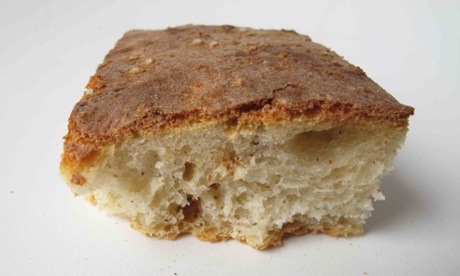
The yeast
Some focaccia variants, notably this amazing-looking cheese-stuffed version, are true flatbreads, made without yeast, but here we're seeking the fluffier sort. If you'd like to use fresh yeast instead of the fast-acting variety that I use, substitute 25g, or 12g of ordinary dried yeast, made up as per packet instructions.
The liquid
All focaccia contains olive oil, from a mere 2 tbsp in Hazan's recipe to 150ml in the River Cafe version. As well as keeping the dough moist, the oil gives the bread its rich flavour, but I suspect the large quantity is also responsible for the slightly soft crust of the River Cafe loaf, so I'm going to reduce the amount slightly.
The principal liquid, however - as in any bread - is water, and lots of it; Hartnett warns the novice baker not to be afraid of adding too much: "It can never be too wet - just trust me on this - it will come together. Too much flour and you end up with something resembling a doorstop."
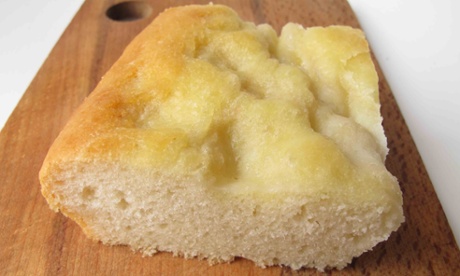
She's right. The drier doughs are indeed denser and heavier, and it's almost safest - given the difficulties of precision when it comes to hydration, which depends on any number of things from the flour you use to the humidity of the day you bake - to be as vague as the River Cafe, which simply instructs one to add enough water to make a "very soft and pliable dough". Thus the figure below should simply be taken as a guide. As in Hazan's recipe, add the liquid in stages until you have a soft but workable dough.
The method
Perhaps it's the temperature of my kitchen in comparison to that of a professional one, but I don't find the short rising time in Locatelli's recipe sufficient to allow the dough to double in size (which is another argument for using the instructions below as a guideline only - exactly how long everything takes will depend on the circumstances in which you make it), and making sure the dough has time to rise properly will ensure a structurally satisfactory result with plenty of air pockets.
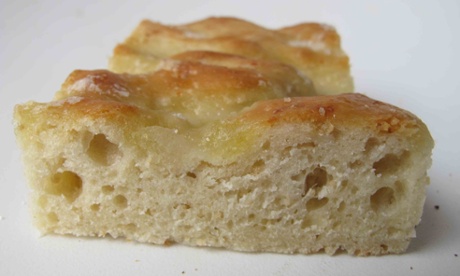
It's easiest to knead wet doughs like this in a food mixer, but if you don't have one, oil your work surface rather than flouring it, so that you don't add any more dry ingredients to the mix.
That said, Locatelli's bread boasts the best examples of those "dimples" that are such a characteristic feature of the focaccia - I think because his are made directly before baking, as opposed to before the second proof.
The baking
As with all breads, a very hot oven gives the best results - and baking it on a hot pizza stone or sheet, as Hartnett and Hazan suggest, will give your bread a pleasingly crisp bottom. Spraying a little water into the hot oven to create steam, as the former also recommends, will also help to create a decent crust.
The brine
Locatelli and others pour a mixture of oil, water and salt on top of their loaves before baking, which, as the River Cafe observes, may seem strange "but the water helps to keep the dough soft and moist in some of the grooves". Be careful not to overdo it, though, or the loaf won't brown on top. And don't feel the need to overload it with salt, either: a mere teaspoon should be quite sufficient given how much there is in the dough.
Do feel free to add herbs (rosemary sprigs are nice), olives, tomatoes, and so on. And, if you're feeling really adventurous, the River Cafe even does a dessert version with black grapes and fennel seeds. Personally, I'd draw the line at this salted-caramel version, but each to their own.
The perfect focaccia
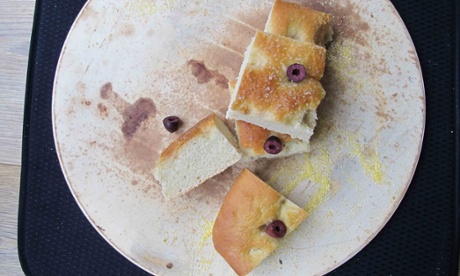
(Makes one large loaf)
375g strong white bread flour
375g "tipo 00" flour (sometimes sold as pasta flour)
1 tbsp fine sea salt
8g active dry yeast
130ml extra-virgin olive oil (100ml for the dough; 30ml for the topping, mixed with 30ml water and 1 tsp salt flakes)
Water
2 tbsp coarse semolina or cornmeal (optional)
Put the flours in a large mixing bowl with the salt and yeast. Whisk well to combine, then make a hole in the middle and add 100ml olive oil, plus 300ml water. Stir together and add more water (I used about 100ml more) until you have a very soft, but not too sticky, dough.
Knead until soft and elastic; in a food mixer (preferable) on a medium-slow speed for about 7 minutes, or by hand on a lightly oiled work surface for 10-12 minutes. Put the dough on a lightly oiled rimless baking sheet and leave to rise in a draught-free place for 60-90 minutes until roughly doubled in size.
Knock back the dough, and lightly dust the baking tray with the semolina, if using. Gently press the dough out with your fingers to fit the baking tray. Brush with olive oil and leave to rise again for about another hour, or until doubled in size again. When this time has nearly elapsed, heat the oven to 220C and put a pizza stone or baking tray in there to heat up. If you have a water spray, ready it.
Whisk together the remaining 30ml olive oil with 30ml water until emulsified. Transfer the dough to you pizza stone or baking tray and poke dimples into the surface of the focaccia with your fingertips. Pour the oil-and-water mixture on top and scatter with the salt flakes, then place in the oven and squirt a little water into the base of the oven. Bake for about 25 minutes, or until golden on top - keep an eye on it. The focaccia is best eaten warm.
Focaccia - is it the king of Italian breads, or do you prefer ciabatta, farinata or carta da musica? What do you like to top yours with, and how do you eat it: straight, or as a gloriously oily sandwich?






